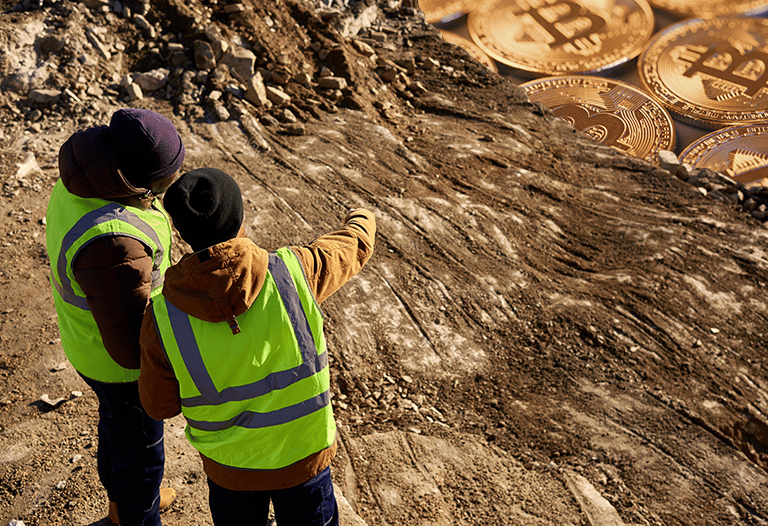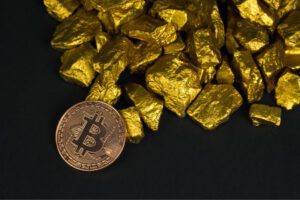
Table of Contents
ToggleIt is logically deducible that prior to designing the system and infrastructure behind bitcoin, Satoshi Nakamoto undertook a detailed analysis of the life cycle of gold. The similarities we find between the two assets are abundant and begin with the process that creates new units of BTC, the mining of cryptocurrencies.
But it is not only in the act of mining that these assets coincide. Those who are in charge of bringing each new Bitcoin unit to life share a name with those individuals who extract from the earth the most precious of our planet’s minerals, the miners.
There is no doubt that Bitcoin set standards that govern the development of the crypto-world to date. In this sense, different networks have adopted, over the years, the method created by Satoshi, mining, to create new units of their native cryptocurrencies. Let’s learn how cryptocurrency mining works.
Crypto mining
Cryptocurrency mining is the process by which new units of the native currency of a blockchain are created through the “Proof of Work” consensus mechanism. The people in charge of this task are called miners and are responsible for:
- Collect transactions performed by users and verified by the nodes
- Organize them into a block
- Solving a complex mathematical problem
- Sign the block, with the result of that problem, and add it to the Bitcoin network.
- Waiting for a certain number of confirmations and receiving a reward
These rewards, which the miner receives for performing his task, are new units of BTC, which are created in this process. Therefore, we can summarize that the mining process yields two results:
- New blocks, which are added to the network.
- New units of, in this case, bitcoin
Although, with this small introduction we have covered in a general way the activity of cryptocurrency mining, there is still a lot of material to be cut on the subject. Let’s learn about the history and evolution of this noble task, without which I would probably not be writing these lines today.
History and evolution of cryptocurrency mining
On January 3, 2009, Satoshi Nakamoto started the Bitcoin blockchain by mining the first block of the network. The reward for mining the famous genesis block was 50 BTC units. Can you imagine receiving such an amount of bitcoin for mining a block?
The number is shocking since we know what happened to the first cryptocurrency in history and its price. However, at the time, it was an experiment barely known to a few cryptographers who had some relationship with Satoshi, via forums and email communication.
In those early days, a simple computer was enough to participate in the Bitcoin network as a miner. The pioneers of this great economic-computer adventure, during the early years, made huge amounts of bitcoin in exchange for a simple proof of work.
The beginning of the end of mining for all
As BTC overcame various obstacles and its price increased, technological efforts began to focus on improving the mining hardware. First powerful video boards, then combining them into “mining rigs” and then powerful ASIC miners. This transformed Satoshi’s dream that “anyone could be a bitcoin miner”, into an activity for large industrial conglomerates that have:
- Large spaces to house a mining farm
- Huge amounts of money to pay for electricity consumption
- Enough purchasing power to acquire the hardware necessary to attempt to mine a new block of Bitcoin
However, if we have learned anything from human beings, it is that they will never stop looking for options and, if they do not exist, they will invent them. This was how many blockchains, which used the mining process as a method to give birth to new units of their own cryptos, tried to capture those former bitcoin miners, displaced by large mining corporations.
Alternatives
Ethereum, alone, was able to host a large number of miners and prove to be a profitable activity. But, setbacks do not cease to hit these ecosystem players. As we already know, after The Merge, Ethereum said goodbye to cryptocurrency mining, condemning countless mining equipment to the sad task of gathering dust.
Cryptocurrency mining, individually, is not going through its best days. However, Bitcoin seems destined never to abandon the mining process, so the monstrous mining farms continued to produce blocks and bring new units of BTC to the insatiable market.
Given a brief historical context, let’s take an even deeper look at how the mining process works.

How does cryptocurrency mining work?
As I explained above, cryptocurrency mining is the process by which, in a Proof of Work network:
- New blocks are created
- New cryptocurrency units are born
Now, it is convenient to take a deeper look at this process and understand how new Bitcoin or other cryptocurrencies are created. Given its popularity, simplicity and position as the king of the ecosystem, let’s use BTC to understand this process.
Bitcoin mining
It is possible to summarize the cryptocurrency mining process as follows:
- Bitcoin network users send and receive BTC units (e.g. John sends Peter 0.1 BTC).
- These shipments arrive as transactions to the nodes, which verify them.
- Once verified, the transactions are sent to the famous mempool, where they await inclusion in a block.
- Miners use these transactions and sort them into a block.
- With this provisional block, they use their computational power to solve an extremely complex mathematical problem by throwing a series of numbers at random until they find the solution.
- The miner who solves the problem before the rest, signs the block and adds it to the Bitcoin blockchain.
- Mining, as such, occurs in the first transaction of the new block, in which the miner creates a transaction for himself of a certain amount of BTC, currently 6.25, and thus issues the new units of bitcoins.
As we have learned throughout this article, in the beginning, it was possible to mine with a PC. But the mathematical problem to be solved to sign a new block on the network has become more complex as the technology required to solve it has grown. As technology improves, the mining hardware evolves and, therefore, today it is practically impossible to mine a block without one of the powerful ASIC miners, created specifically for this task.
Is cryptocurrency mining profitable today?
Undoubtedly, it is a question that all those who are outside the mining circuit often ask. As we have learned in the previous point, individual bitcoin mining is practically impossible. Setting up a BTC miner today would involve expenses that would only be rewarded after a lucky break, the odds of which are extremely slim.
After the arrival of bitcoin mining farms, small-scale mining activity turned to the Ethereum network. During the last 7 years, those who took advantage of the high times of popularity of the DeFi world, NFTs and different movements around this network, managed to obtain significant profits.
However, Ethereum has forever left the consensus of Proof of Work for Proof of Stake, leaving a lot of mining hardware without a network on which to occupy its computational power. For this reason, the mining landscape has changed substantially in September 2022. The uncertainty surrounding its future invites us to conclude that, at least until we have a Proof of Work network with a significant volume of movement, mining today is not a very profitable activity for those who intend to start mining. But this will always depend on the price of the crypto-asset being mined, since if, for example, the price of Bitcoin multiplies by 10 times, mining a Bitcoin today could be highly profitable.

Other cryptocurrencies for mining
If you want to know some of the existing options for mining cryptocurrencies, you can check the following articles of our blog:
- How to mine Bitcoin (BTC)?
- How to mine Bitcoin Cash (BCH)?
- How to mine Kadena (KDA)?
- How to mine Enjin Coin (ENJ)?
- How to mine Filecoin (FIL)?
- How to mine Siacoin (SC)?
- How to mine Ravencoin (RVN)?
- How to mine Dogecoin (DOGE)?
- How to mine Ethereum Classic (ETC)?
- How to mine Zcash (ZEC)?
- How to mine Litecoin (LTC)?
- How to mine Monero (XMR)?
The future of cryptocurrency mining
From reading this article, it is clear that cryptocurrency mining is far from its golden age. After the abandonment of the “Proof of Work” consensus by the Ethereum blockchain, the former miners of that network have not yet found a place to use their computational power and the number of “mining rigs” for sale or simply in disuse is only increasing.
On the other hand, the Bitcoin community does not contemplate a change in its consensus, which means that mining of this cryptocurrency will continue. However, this is not encouraging news for individual miners, but for the large mining conglomerates, which have gradually centralized this activity.
The great unknown is to know the destiny that the former Ethereum miners will take in the future. To date, the only certainty we have is that BTC mining will continue until the last bitcoin is mined.








